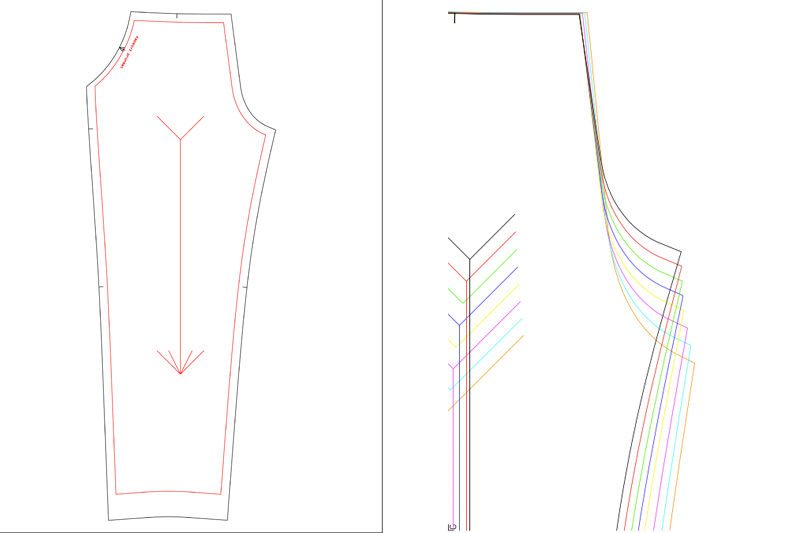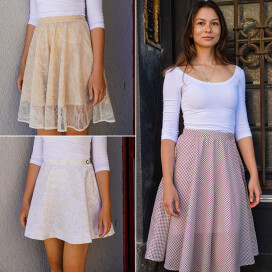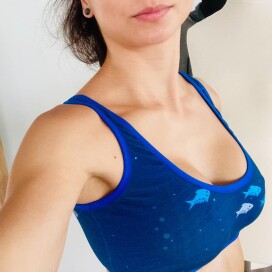The pattern for women’s summer dress BREEZE
- This dress pattern is constructed in a professional program for clothing pattern development and it is available in sizes 32–46 and 48–60 (find size chart below).
- Every pattern has multiple PDF files (A4 all sizes, A4 individual sizes, A1/A0, sewing guide, etc.) so the files are delivered as a single ZIP archive. You can unzip the archive online or download special software to unzip the files (such as WinRAR for Windows or The Unarchiver for Mac). Please use a computer to unzip and print the pattern, there might be issues with printing on mobiles or tablets.
- When printing, be sure to select "Poster" and size "100%" to print the pattern correctly.
Sewing instructions:
We have created two detailed photo tutorials for this pattern:
Help center:
If you have any questions about the pattern or get stuck while sewing, feel free to visit our help center:
Skill level:
- This pattern is suitable for advanced sewers.
- How do I know the level of my sewing skills?
Recommended material:
There are many suitable fabrics for this dress. It is important to use some kind of lighter woven fabric (rigid, inflexible fabrics) so that the skirt is not very heavy due to its volume.
For the more festive dress (grey-blue) I used micro satin from Dumlatek.cz store: Micro satin.
For the dark dress, I used chiffon with a designer print from Tufka.cz store: Chiffon - mushrooms.
You can also use:
- Blouse fabrics (airy and flowing)
- Light viscose
- Linen fabrics
- You can also use lace to sew a beautiful and light version of the dress. It is necessary to add lining to the lace version. I’m generally in favor of using natural materials, so I highly recommend sewing the lining from viscose. Viscose is a bit prone to crumpling, but it is airy and very comfortable to wear. (If you use “plastic” lace with “plastic” lining, you will feel uncomfortable and sweaty in summer…)
- Chiffon - great choice for a summer dress – I recommend trying this one out, you will feel like a fairy! Working with chiffon requires some practice and patience, so I do not recommend this material to beginners. With a little effort, however, you can conjure incredibly beautiful pieces with it. Instructions on how to sew from chiffon and other fine fabrics can be found in this article: How to sew fine fabrics
The required amount of material:
(for 140 cm / 55" wide fabric)
- Primary fabric
- Sizes 32–46: 2.5 m / 100"
- Sizes 48–60: 3.1 m / 122"
- Lining fabric (optional)
- Sizes 32–46: 1 m / 40"
- Sizes 48–60: 1.6 m / 63"
Size chart:

You can find more info about the size charts here:
There are two versions of this pattern:
(after purchase you will receive both versions)
- 1st version (one size view) – PDF A4 – pattern in individual sizes with seam allowances outlined– all individual sizes of the pattern (pattern of each size shows sewing lines and seam allowances are outlined too).
- 2nd version (classic view) – PDF A4 pattern showing all sizes without seam allowances - all sizes are outlined “in one picture”(each in its own color) without seam allowances.

You can choose what works best for you. The advantage of the classic view (where all the sizes are shown) is that you can easily customize your pattern to fit body types in between the chart sizes. One size view saves time during preparation - you do not have to think where and how much to add for the seams, because everything is already there.
When and how do I receive my pattern?
After the payment has been credited to the account, I will immediately send the pattern with sewing instructions in PDF/ZIP format to your e-mail address. Then you just need to print and assemble the pattern of the desired size. Check out my article on how to assemble a paper pattern from A4 pages.
Declaration
Pattern, including instructions and all photographs, is a copyrighted work, and any distribution, copying, or disclosure to third parties is prohibited and will be considered a violation of the Copyright Act (Copyright Act, Act No. 121/2000 Coll. / Zákon o právu autorském – Zákon č. 121/2000 Sb., Česká Republika), which may be prosecuted. Contents of the pattern (and instructions) are based on the personal experiences of the author. Your successes and possible failures are in your hands and the author bears no responsibility for them. But that doesn’t mean you’re on your own. Whenever you need advice, please do not hesitate to contact me at petra@picolly.com
Notice to companies
The pattern is not intended for commercial use. If you are a tailor (for example) and you want to use any of my patterns for commercial purposes, please do not hesitate to contact me. I will be happy to discuss my options with you and create a bespoke offer for you.
For best results, please read the following:
- The patterns are constructed in ready-made sizes because it is not possible to construct a pattern for all body types (the size chart would get too congested).
- To make the clothes fit the individual figure perfectly, you need to carefully measure them first. Then compare measurements with the size chart and paper pattern. That is the only way to find the right pattern size.
- Besides, it’s almost always necessary to adjust the pattern slightly to make it fit perfectly. (Even if we have two women whose measurements are the same, they will differ in other ways – one of them may have a narrower back and a larger bust, the other may be more muscular with a smaller bust. One of them may also have wider hips and flatter buttocks, the other may have narrower hips and rounder buttocks…) Patterns (and their sizes) are only rough guidelines. If you are going for a perfect fit, you need to perform fitting tests and adjust the garments accordingly. Sewing is a creative activity and you need to take into account that each of us is built differently. THIS APPLIES TO CHILDREN’S AND MEN’S CLOTHES TOO – WE ARE ALL UNIQUE.
- If you are using some pattern for the first time, always sew a “test sample” from a cheaper fabric first. Mark any adjustments in the paper pattern and then use it to sew the final product. It is a classic tailoring method. No two fabrics are the same, therefore, please note that what works with one fabric may not work with another. That is why you should always sew test samples. Sewing is not like baking, you can’t just pick the pattern and expect the perfect results without some measuring, testing, and adjusting. That’s just how it works.
- I also recommend temporarily stitching all seams that affect circumferences (such as side seams, instep seams, etc.) before sewing. So, you can try the garment on and adjust it if necessary. Do not underestimate ironing and testing the clothes during the sewing process.
- Also, don’t forget to carefully mark seam allowances. Beginners often forget about them. It is necessary to measure seam allowances with the measuring tape around the entire pattern and then sew along the correct sewing lines – seam allowances width away from the cutting edges. Careless work with the seam allowances can result in large deviations in the overall widths and lengths of the individual pieces.
- When positioning the paper pattern pieces always make sure that the pieces are oriented correctly.
Free patterns:
Not sure whether to buy a pattern? Not sure what the pattern will look like and if you ever be able to put it together? Download one of my patterns for free and see what it looks like and try using it. Free patterns are in the same format as the patterns available in the store. You check them out here:
Worth reading:
- How to assemble the paper pattern
- How to transfer the paper pattern to the fabric
- How to adjust the pattern
- How to scale the pattern proportionally
- How to baste the fabric
- How to choose a sewing machine needle
- Sewing elastic fabrics with a regular sewing machine – 4 steps to success
- 5 sewing tools that you cannot buy in the haberdashery
- How to choose a sewing machine – 5 important tips
- Sewing tips and tricks.
If you want to take your sewing skills one step further, I suggest you go through:

















































